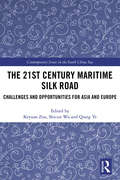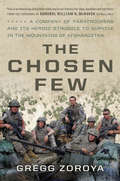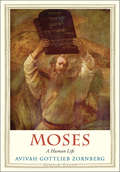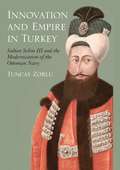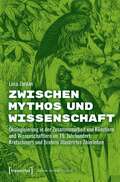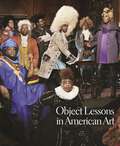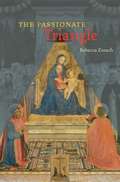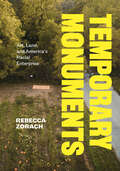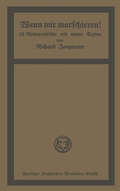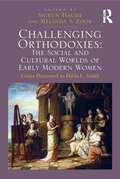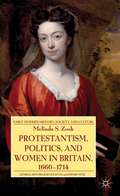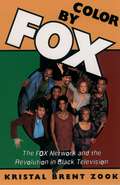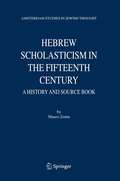- Table View
- List View
The 21st Century Maritime Silk Road: Challenges and Opportunities for Asia and Europe (Contemporary Issues in the South China Sea)
by Keyuan Zou Shicun Wu Qiang YeThis book explores the opportunities and challenges that both Europe and Asia face under the framework of the 21st Century Maritime Silk Road Initiative. The 21st Century Maritime Silk Road Initiative (MSR Initiative), put forward by the Chinese government together with the Silk Road Economic Belt, reflects China’s ambition and vision to shape the global economic and political order. The first step and priority under the MSR Initiative, according to documents issued by China, is to build three ‘Blue Economic Passages’ linking China with the rest of the world at sea, two of which will connect China with Europe. This initiative, however, still faces enormous challenges of geopolitical suspicion and security risks. This book seeks to assess these risks and their causes for the cooperation between the Eurasian countries under the framework of MSR and puts forward suggestions to deal with these risks in the interdisciplinary perspectives of international relations and international law. Featuring a global team of contributors, this book will be of much interest to students of Asian politics, maritime security, international law and international relations.
The 21st Century Maritime Silk Road: Challenges and Opportunities for Asia and Europe (Contemporary Issues in the South China Sea)
by Keyuan Zou Shicun Wu Qiang YeThis book explores the opportunities and challenges that both Europe and Asia face under the framework of the 21st Century Maritime Silk Road Initiative. The 21st Century Maritime Silk Road Initiative (MSR Initiative), put forward by the Chinese government together with the Silk Road Economic Belt, reflects China’s ambition and vision to shape the global economic and political order. The first step and priority under the MSR Initiative, according to documents issued by China, is to build three ‘Blue Economic Passages’ linking China with the rest of the world at sea, two of which will connect China with Europe. This initiative, however, still faces enormous challenges of geopolitical suspicion and security risks. This book seeks to assess these risks and their causes for the cooperation between the Eurasian countries under the framework of MSR and puts forward suggestions to deal with these risks in the interdisciplinary perspectives of international relations and international law. Featuring a global team of contributors, this book will be of much interest to students of Asian politics, maritime security, international law and international relations.
The Chosen Few: A Company of Paratroopers and Its Heroic Struggle to Survive in the Mountains of Afghanistan
by Gregg ZoroyaThe never-before-told story of one of the most decorated units in the war in Afghanistan and its fifteen-month ordeal that culminated in the 2008 Battle of Wanat, the war's deadliestA single company of US paratroopers--calling themselves the "Chosen Few"--arrived in eastern Afghanistan in late 2007 hoping to win the hearts and minds of the remote mountain people and extend the Afghan government's reach into this wilderness. Instead, they spent the next fifteen months in a desperate struggle, living under almost continuous attack, forced into a slow and grinding withdrawal, and always outnumbered by Taliban fighters descending on them from all sides.Month after month, rocket-propelled grenades, rockets, and machine-gun fire poured down on the isolated and exposed paratroopers as America's focus and military resources shifted to Iraq. Just weeks before the paratroopers were to go home, they faced their last--and toughest--fight. Near the village of Wanat in Nuristan province, an estimated three hundred enemy fighters surrounded about fifty of the Chosen Few and others defending a partially finished combat base. Nine died and more than two dozen were wounded that day in July 2008, making it arguably the bloodiest battle of the war in Afghanistan.The Chosen Few would return home tempered by war. Two among them would receive the Medal of Honor. All of them would be forever changed.
Moses: A Human Life (Jewish Lives)
by Avivah Gottlieb ZornbergAn unprecedented portrait of Moses's inner world and perplexing character, by a distinguished biblical scholar No figure looms larger in Jewish culture than Moses, and few have stories more enigmatic. Avivah Gottlieb Zornberg, acclaimed for her many books on Jewish thought, turns her attention to Moses in this remarkably rich, evocative book. Drawing on a broad range of sources—literary as well as psychoanalytic, a wealth of classical Jewish texts alongside George Eliot, W. G. Sebald, and Werner Herzog—Zornberg offers a vivid and original portrait of the biblical Moses. Moses's vexing personality, his uncertain origins, and his turbulent relations with his own people are acutely explored by Zornberg, who sees this story, told and retold, as crucial not only to the biblical past but also to the future of Jewish history.
Innovation and Empire in Turkey: Sultan Selim III and the Modernisation of the Ottoman Navy
by Tuncay ZorluOttoman naval technology underwent a transformation under the rule of Sultan Selim III. New types of sailing warships such as two- and three-decked galleons, frigates and corvettes began to dominate the Ottoman fleet, rendering the galley-type oared ships obsolete. This period saw technological innovations such as the adoption of the systematic copper sheathing of the hulls and bottoms of Ottoman warships from 1792-93 onwards and the construction of the first dry dock in the Golden Horn.The changing face of the Ottoman Navy was facilitated by the influence of the British, Swedish and French in modernising both the shipbuilding sector and the conduct of naval warfare. Through such measures as training Ottoman shipbuilders, heavy reliance on help from foreign powers gave way to a new trajectory of modernization. Using this evidence Zorlu argues that although the Ottoman Empire was a major and modern independent power in this period, some technological dependence on Europe remained.
Innovation and Empire in Turkey: Sultan Selim III and the Modernisation of the Ottoman Navy (Library Of Ottoman Studies)
by Tuncay ZorluOttoman naval technology underwent a transformation under the rule of Sultan Selim III. New types of sailing warships such as two- and three-decked galleons, frigates and corvettes began to dominate the Ottoman fleet, rendering the galley-type oared ships obsolete. This period saw technological innovations such as the adoption of the systematic copper sheathing of the hulls and bottoms of Ottoman warships from 1792-93 onwards and the construction of the first dry dock in the Golden Horn. The changing face of the Ottoman Navy was facilitated by the influence of the British, Swedish and French in modernising both the shipbuilding sector and the conduct of naval warfare. Through such measures as training Ottoman shipbuilders, heavy reliance on help from foreign powers gave way to a new trajectory of modernization. Using this evidence Zorlu argues that although the Ottoman Empire was a major and modern independent power in this period, some technological dependence on Europe remained.'A valuable and well researched study… Zorlu ably surveys and analyses the developments which took place in Ottoman shipbuilding technology in the late eighteenth and early nineteenth centuries.' - Colin Heywood, University of Hull
The Emergence of a Hero: A Tale of Romantic Love in Russia around 1800 (Emotions in History)
by Andrei ZorinThe Emergence of a Hero is dedicated to the history of Russian emotional culture of the late eighteenth and early nineteenth centuries - the epoch when the court Masonic lodges and literature were competing for the monopoly on the 'symbolic images of feeling' that an educated and Europeanised Russian was supposed to interiorize and reproduce. The case study in the centre of the study is the story of the life and death of Andrei Turgenev (1781-1803), the author of a confessional diary, a gifted poet, and an early Russian Romantic who failed to live up to the principles and models he cherished. Brought up on the patterns of emotions he found in works of Rousseau, Sterne, and the authors of Sturm and Drang, he soon found them too narrow for his individuality, and navigated towards a more mature nineteenth century Romanticism, but was not able to make this transition. Turgenev experimented not so much in his literary work as in his life. The reconstruction of this convoluted and enigmatic case is based on archival research and innovative analysis of individual emotional experience.
The Emergence of a Hero: A Tale of Romantic Love in Russia around 1800 (Emotions in History)
by Andrei ZorinThe Emergence of a Hero is dedicated to the history of Russian emotional culture of the late eighteenth and early nineteenth centuries - the epoch when the court Masonic lodges and literature were competing for the monopoly on the 'symbolic images of feeling' that an educated and Europeanised Russian was supposed to interiorize and reproduce. The case study in the centre of the study is the story of the life and death of Andrei Turgenev (1781-1803), the author of a confessional diary, a gifted poet, and an early Russian Romantic who failed to live up to the principles and models he cherished. Brought up on the patterns of emotions he found in works of Rousseau, Sterne, and the authors of Sturm and Drang, he soon found them too narrow for his individuality, and navigated towards a more mature nineteenth century Romanticism, but was not able to make this transition. Turgenev experimented not so much in his literary work as in his life. The reconstruction of this convoluted and enigmatic case is based on archival research and innovative analysis of individual emotional experience.
Age of Wolf and Wind: Voyages through the Viking World
by Davide ZoriThe Vikings continue to fascinate us because their compelling stories connect with universal human desires for exploration and adventure. In Age of Wolf and Wind: Voyages through the Viking World, author Davide Zori argues that recent advances in excavation and archaeological science, coupled with a re-evaluation of oral traditions and written sources, inspire the telling of new and engaging stories that further our understanding of the Viking Age. Drawing upon his fieldwork experience across the Viking world, he proposes that the best method for weaving together these narratives is a balanced, interdisciplinary approach that integrates history, archaeology, and new scientific techniques. The book delves into key questions of the Viking Age, such as the motivations of Scandinavians to board open wooden ships to raid England or cross the North Atlantic in search of new worlds beyond Europe. Each chapter offers new conclusions about the Vikings--their views on death, their raiding tactics, their lavish feasts, their forging of powerful medieval states, and many others. In each case, Zori brings together written sources, archaeology, and the natural sciences. The dialogues he creates between these three separate data sets result in an entanglement of confirmation (texts, archaeology, and science affirming the same story), contradiction (texts, archaeology, and science telling incompatible stories) and complementarity (texts, archaeology, and science contributing mutually enriching stories). This optimistic yet critical treatment of the sources allows for a holistic picture of the Viking Age to emerge, one that is accessible to a general audience but simultaneously offers new insights into current key issues of scholarly debate.
Age of Wolf and Wind: Voyages through the Viking World
by Davide ZoriThe Vikings continue to fascinate us because their compelling stories connect with universal human desires for exploration and adventure. In Age of Wolf and Wind: Voyages through the Viking World, author Davide Zori argues that recent advances in excavation and archaeological science, coupled with a re-evaluation of oral traditions and written sources, inspire the telling of new and engaging stories that further our understanding of the Viking Age. Drawing upon his fieldwork experience across the Viking world, he proposes that the best method for weaving together these narratives is a balanced, interdisciplinary approach that integrates history, archaeology, and new scientific techniques. The book delves into key questions of the Viking Age, such as the motivations of Scandinavians to board open wooden ships to raid England or cross the North Atlantic in search of new worlds beyond Europe. Each chapter offers new conclusions about the Vikings--their views on death, their raiding tactics, their lavish feasts, their forging of powerful medieval states, and many others. In each case, Zori brings together written sources, archaeology, and the natural sciences. The dialogues he creates between these three separate data sets result in an entanglement of confirmation (texts, archaeology, and science affirming the same story), contradiction (texts, archaeology, and science telling incompatible stories) and complementarity (texts, archaeology, and science contributing mutually enriching stories). This optimistic yet critical treatment of the sources allows for a holistic picture of the Viking Age to emerge, one that is accessible to a general audience but simultaneously offers new insights into current key issues of scholarly debate.
Zwischen Mythos und Wissenschaft: Ökologisierung in der Zusammenarbeit von Künstlern und Wissenschaftlern im 19. Jahrhundert: Kretschmers und Brehms Illustrirtes Thierleben (Human-Animal Studies #22)
by Luca ZordanDurch die Vorstellung naturwissenschaftlicher Bilder, welche aus Kontexten der künstlerisch-wissenschaftlichen Kooperation stammen, skizziert Luca Zordan Symptome einer sich im 19. Jahrhundert entfaltenden Ökologisierung. Der Fokus richtet sich dabei auf den Beitrag von Tierillustrationen in Publikationen aus der Zeit der Popularisierung des Wissens zur Entwicklung hybrider Ansichten, welche Phänomene einer Verwandtschaft von Mensch und Tier ausdrücken. Exemplarisch dienen zu dieser Analyse Holzstiche des Künstlers Robert Kretschmer in Alfred Brehms Illustrirtes Thierleben.
Object Lessons in American Art
by Rebecca Zorach Horace D. Ballard Kirsten Pai Buick Ellery E. Foutch Karl Kusserow Jeffrey Richmond-MollA rich exploration of American artworks that reframes them within current debates on race, gender, the environment, and moreObject Lessons in American Art explores a diverse gathering of Euro-American, Native American, and African American art from a range of contemporary perspectives, illustrating how innovative analysis of historical art can inform, enhance, and afford new relevance to artifacts of the American past. The book is grounded in the understanding that the meanings of objects change over time, in different contexts, and as a consequence of the ways in which they are considered. Inspired by the concept of the object lesson, the study of a material thing or group of things in juxtaposition to convey embodied and underlying ideas, Object Lessons in American Art examines a broad range of art from Princeton University’s venerable collections as well as contemporary works that imaginatively appropriate and reframe their subjects and style, situating them within current social, cultural, and artistic debates on race, gender, the environment, and more.Distributed for the Princeton University Art Museum
The Passionate Triangle
by Rebecca ZorachTriangles abounded in the intellectual culture of early modern Europe—the Christian Trinity was often mapped as a triangle, for instance, and perspective, a characteristic artistic technique, is based on a triangular theory of vision. Renaissance artists, for their part, often used shapes and lines to arrange figures into a triangle on the surface of a painting—a practice modern scholars call triangular composition. But is there secret meaning in the triangular arrangements artists used, or just a pleasing symmetry? What do triangles really tell us about the European Renaissance and its most beguiling works of art? In this book, Rebecca Zorach takes us on a lively hunt for the triangle’s embedded significance. From the leisure pursuits of Egyptian priests to Jacopo Tintoretto’s love triangles, Zorach explores how the visual and mathematical properties of triangles allowed them to express new ideas and to inspire surprisingly intense passions. Examining prints and paintings as well as literary, scientific, and philosophical texts, The Passionate Triangle opens up an array of new ideas, presenting unexpected stories of the irrational, passionate, melancholic, and often erotic potential of mathematical thinking before the Scientific Revolution.
The Passionate Triangle
by Rebecca ZorachTriangles abounded in the intellectual culture of early modern Europe—the Christian Trinity was often mapped as a triangle, for instance, and perspective, a characteristic artistic technique, is based on a triangular theory of vision. Renaissance artists, for their part, often used shapes and lines to arrange figures into a triangle on the surface of a painting—a practice modern scholars call triangular composition. But is there secret meaning in the triangular arrangements artists used, or just a pleasing symmetry? What do triangles really tell us about the European Renaissance and its most beguiling works of art? In this book, Rebecca Zorach takes us on a lively hunt for the triangle’s embedded significance. From the leisure pursuits of Egyptian priests to Jacopo Tintoretto’s love triangles, Zorach explores how the visual and mathematical properties of triangles allowed them to express new ideas and to inspire surprisingly intense passions. Examining prints and paintings as well as literary, scientific, and philosophical texts, The Passionate Triangle opens up an array of new ideas, presenting unexpected stories of the irrational, passionate, melancholic, and often erotic potential of mathematical thinking before the Scientific Revolution.
The Passionate Triangle
by Rebecca ZorachTriangles abounded in the intellectual culture of early modern Europe—the Christian Trinity was often mapped as a triangle, for instance, and perspective, a characteristic artistic technique, is based on a triangular theory of vision. Renaissance artists, for their part, often used shapes and lines to arrange figures into a triangle on the surface of a painting—a practice modern scholars call triangular composition. But is there secret meaning in the triangular arrangements artists used, or just a pleasing symmetry? What do triangles really tell us about the European Renaissance and its most beguiling works of art? In this book, Rebecca Zorach takes us on a lively hunt for the triangle’s embedded significance. From the leisure pursuits of Egyptian priests to Jacopo Tintoretto’s love triangles, Zorach explores how the visual and mathematical properties of triangles allowed them to express new ideas and to inspire surprisingly intense passions. Examining prints and paintings as well as literary, scientific, and philosophical texts, The Passionate Triangle opens up an array of new ideas, presenting unexpected stories of the irrational, passionate, melancholic, and often erotic potential of mathematical thinking before the Scientific Revolution.
The Passionate Triangle
by Rebecca ZorachTriangles abounded in the intellectual culture of early modern Europe—the Christian Trinity was often mapped as a triangle, for instance, and perspective, a characteristic artistic technique, is based on a triangular theory of vision. Renaissance artists, for their part, often used shapes and lines to arrange figures into a triangle on the surface of a painting—a practice modern scholars call triangular composition. But is there secret meaning in the triangular arrangements artists used, or just a pleasing symmetry? What do triangles really tell us about the European Renaissance and its most beguiling works of art? In this book, Rebecca Zorach takes us on a lively hunt for the triangle’s embedded significance. From the leisure pursuits of Egyptian priests to Jacopo Tintoretto’s love triangles, Zorach explores how the visual and mathematical properties of triangles allowed them to express new ideas and to inspire surprisingly intense passions. Examining prints and paintings as well as literary, scientific, and philosophical texts, The Passionate Triangle opens up an array of new ideas, presenting unexpected stories of the irrational, passionate, melancholic, and often erotic potential of mathematical thinking before the Scientific Revolution.
Temporary Monuments: Art, Land, and America's Racial Enterprise
by Rebecca ZorachHow art played a central role in the design of America’s racial enterprise—and how contemporary artists resist it. Art has long played a key role in constructing how people understand and imagine America. Starting with contemporary controversies over public monuments in the United States, Rebecca Zorach carefully examines the place of art in the occupation of land and the upholding of White power in the US, arguing that it has been central to the design of America’s racial enterprise. Confronting closely held assumptions of art history, Zorach looks to the intersections of art, nature, race, and place, working through a series of symbolic spaces—the museum, the wild, islands, gardens, home, and walls and borders—to open and extend conversations on the political implications of art and design. Against the backdrop of central moments in American art, from the founding of early museums to the ascendancy of abstract expressionism, Zorach shows how contemporary artists—including Dawoud Bey, Theaster Gates, Maria Gaspar, Kerry James Marshall, Alan Michelson, Dylan Miner, Postcommodity, Cauleen Smith, and Amanda Williams—have mined the relationship between environment and social justice, creating works that investigate and interrupt White supremacist, carceral, and environmentally toxic worlds. The book also draws on poetry, creative nonfiction, hip-hop videos, and Disney films to illuminate crucial topics in art history, from the racial politics of abstraction to the origins of museums and the formation of canons.
Wenn wir marschieren!: 16 Armeemärsche mit neuen Texten
by Richard ZoozmannDieser Buchtitel ist Teil des Digitalisierungsprojekts Springer Book Archives mit Publikationen, die seit den Anfängen des Verlags von 1842 erschienen sind. Der Verlag stellt mit diesem Archiv Quellen für die historische wie auch die disziplingeschichtliche Forschung zur Verfügung, die jeweils im historischen Kontext betrachtet werden müssen. Dieser Titel erschien in der Zeit vor 1945 und wird daher in seiner zeittypischen politisch-ideologischen Ausrichtung vom Verlag nicht beworben.
Ancient and Early Medieval Kingdoms of the Pamir Region of Central Asia: Historical Shughnān and its Lost Capital
by Muzaffar Zoirshoevich ZoolshoevThis focused study is one of the few analytical resources in English that covers the ancient and early medieval history of one of the least studied areas of the vast mountainous Pamir region of Central Asia: Shughnān. The book brings together scattered fragments of information from a wide range of early Greek, Chinese, Persian, and Arabic sources, the accounts of early European travellers and the scholarly contributions of Soviet and post-Soviet authors, as well as personal accounts and oral history material from the region. Drawing on historical, archaeological, linguistic, and ethnographic data, it provides a holistic overview of the kingdom of Shughnān. It also attempts, for the first time, to identify and locate the town of Kǔhán, which the Chinese historical chronicle, the Táng Shū (Book of the Tang Dynasty, 618–907 CE) describes as the ‘first capital’ of Shughnān. Many archaeological sites are examined and offered as potential candidates for the location of the town of Kǔhán, providing a foundation for future archaeological and ethnolinguistic research in the area. Ancient and Early Medieval Kingdoms of the Pamir Region of Central Asia: Historical Shughnān and its Lost Capital is suitable for students, scholars, and historians studying ancient and early medieval Central Asia, particularly the Pamir region, as well as those interested in Central Asian history and archaeology more broadly.
Ancient and Early Medieval Kingdoms of the Pamir Region of Central Asia: Historical Shughnān and its Lost Capital
by Muzaffar Zoirshoevich ZoolshoevThis focused study is one of the few analytical resources in English that covers the ancient and early medieval history of one of the least studied areas of the vast mountainous Pamir region of Central Asia: Shughnān. The book brings together scattered fragments of information from a wide range of early Greek, Chinese, Persian, and Arabic sources, the accounts of early European travellers and the scholarly contributions of Soviet and post-Soviet authors, as well as personal accounts and oral history material from the region. Drawing on historical, archaeological, linguistic, and ethnographic data, it provides a holistic overview of the kingdom of Shughnān. It also attempts, for the first time, to identify and locate the town of Kǔhán, which the Chinese historical chronicle, the Táng Shū (Book of the Tang Dynasty, 618–907 CE) describes as the ‘first capital’ of Shughnān. Many archaeological sites are examined and offered as potential candidates for the location of the town of Kǔhán, providing a foundation for future archaeological and ethnolinguistic research in the area. Ancient and Early Medieval Kingdoms of the Pamir Region of Central Asia: Historical Shughnān and its Lost Capital is suitable for students, scholars, and historians studying ancient and early medieval Central Asia, particularly the Pamir region, as well as those interested in Central Asian history and archaeology more broadly.
Challenging Orthodoxies: Essays Presented to Hilda L. Smith
by Melinda S. ZookOffering a broad and eclectic approach to the experience and activities of early modern women, Challenging Orthodoxies presents new research from a group of leading voices in their respective fields. Each essay confronts some received wisdom, ’truth’ or orthodoxy in social and cultural, scientific and intellectual, and political and legal traditions, to demonstrate how women from a range of social classes could challenge the conventional thinking of their time as well as the ways in which they have been traditionally portrayed by scholars. Subjects include women's relationship to guns and gunpowder, the law and legal discourse, religion, public finances, and the new science in early modern Europe, as well as women and indentured servitude in the New World. A testament to the pioneering work of Hilda L. Smith, this collection makes a valuable contribution to scholarship in women’s studies, political science, history, religion and literature.
Challenging Orthodoxies: Essays Presented to Hilda L. Smith
by Melinda S. ZookOffering a broad and eclectic approach to the experience and activities of early modern women, Challenging Orthodoxies presents new research from a group of leading voices in their respective fields. Each essay confronts some received wisdom, ’truth’ or orthodoxy in social and cultural, scientific and intellectual, and political and legal traditions, to demonstrate how women from a range of social classes could challenge the conventional thinking of their time as well as the ways in which they have been traditionally portrayed by scholars. Subjects include women's relationship to guns and gunpowder, the law and legal discourse, religion, public finances, and the new science in early modern Europe, as well as women and indentured servitude in the New World. A testament to the pioneering work of Hilda L. Smith, this collection makes a valuable contribution to scholarship in women’s studies, political science, history, religion and literature.
Protestantism, Politics, and Women in Britain, 1660-1714 (Early Modern History: Society and Culture)
by Melinda ZookThis compelling new study examines the intersection between women, religion and politics in the late seventeenth and early eighteenth century in Britain. It demonstrates that what inspired Dissenting and Anglican women to political action was their concern for the survival of the Protestant religion both at home and abroad.
Color by Fox: The Fox Network and the Revolution in Black Television (W.E.B. Du Bois Institute)
by Kristal Brent ZookFollowing the overwhelming success of "The Cosby Show" in the 1980s, an unprecedented shift took place in television history: white executives turned to black dollars as a way of salvaging network profits lost in the war against video cassettes and cable T.V. Not only were African-American viewers watching disproportionately more network television than the general population but, as Nielsen finally realized, they preferred black shows. As a result, African-American producers, writers, directors, and stars were given an unusual degree of creative control over shows such as "The Fresh Prince of Bel Air," "Roc," "Living Single," and "New York Undercover". What emerged were radical representations of African-American memory and experience. Offering a fascinating examination of the explosion of black television programming in the 1980s and 1990s, this book provides, for the first time ever, an interpretation of black TV based in both journalism and critical theory. Locating a persistent black nationalist desire--a yearning for home and community--in the shows produced by and for African-Americans in this period, Kristal Brent Zook shows how the Fox hip-hop sitcom both reinforced and rebelled against earlier black sitcoms from the sixties and seventies. Incorporating interviews with such prominent executives, producers, and stars as Keenen Ivory Wayans, Sinbad, Quincy Jones, Robert Townsend, Charles Dutton, Yvette Lee Bowser, and Ralph Farquhar, this study looks at both production and reception among African-American viewers, providing nuanced readings of the shows themselves as well as the sociopolitical contexts in which they emerged. While black TV during this period may seem trivial or buffoonish to some, Color by Fox reveals its deep-rooted ties to African-American protest literature and autobiography, and a desire for social transformation.
Hebrew Scholasticism in the Fifteenth Century: A History and Source Book (Amsterdam Studies in Jewish Philosophy #9)
by Mauro ZontaA number of Jewish philosophers active in Spain and Italy in the second half of the 15th century (Abraham Bibago, Baruch Ibn Ya'ish, Abraham Shalom, Eli Habillo, Judah Messer Leon) wrote Hebrew commentaries and questions on Aristotle. In these works, they reproduced the techniques and terminology of Late-Medieval Latin Scholasticism, and quoted and discussed Latin texts (by Albert the Great, Thomas Aquinas, William of Ockham, John Duns Scotus, and other authors) about logic, physics, metaphysics, and ethics. All of these works are still unpublished, and they have not yet been either studied, or translated in modern languages. The aim of this book is to give an idea of the extent and character of this hitherto neglected "Hebrew Scholasticism". After a general historical introduction to this phenomenon, and bio-bibliographical surveys of these philosophers, the book gives complete or partial annotated English translations of the most significant Hebrew Scholastical works. It includes also critical editions of some parts of these texts, and a Latin-Hebrew glossary of Scholastical technical terms.
